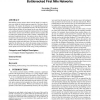Free Online Productivity Tools
i2Speak
i2Symbol
i2OCR
iTex2Img
iWeb2Print
iWeb2Shot
i2Type
iPdf2Split
iPdf2Merge
i2Bopomofo
i2Arabic
i2Style
i2Image
i2PDF
iLatex2Rtf
Sci2ools
NOSSDAV
2010
Springer
2010
Springer
Wireless network interface energy conservation for bottlenecked first mile networks
Placeshifting systems stream videos from the home to a single remote user using the limited upstream capacity of the home broadband link. We analyze the behavior of two placeshifting systems each using two types of broadband networks. We show that the duration between packets did not depend on the way that the servers were sending the packets through the bottleneck link. Even though both of these systems used TCP, the duration between packets did not follow the round trip times either. Instead, it depended on the particular broadband network. Our analysis shows how the bottlenecked first mile network leads to predictable packet delivery at the remote client. Paradoxically, it also leads to shorter periods and a single packet within each data burst. We discuss the limitations imposed by this behavior on a client side energy saving mechanism. We also describe techniques that allow the placeshifting servers to better operate with client side WNIC energy saving mechanisms. Categories and ...
| Added | 14 Oct 2010 |
| Updated | 14 Oct 2010 |
| Type | Conference |
| Year | 2010 |
| Where | NOSSDAV |
| Authors | Surendar Chandra |
Comments (0)

